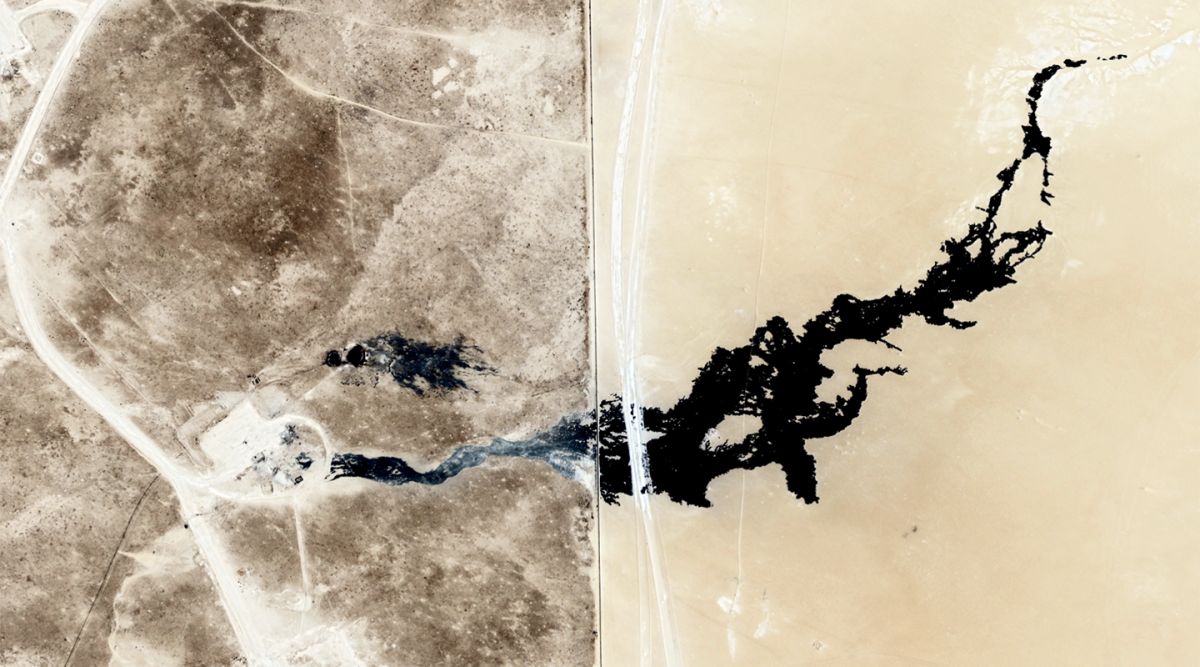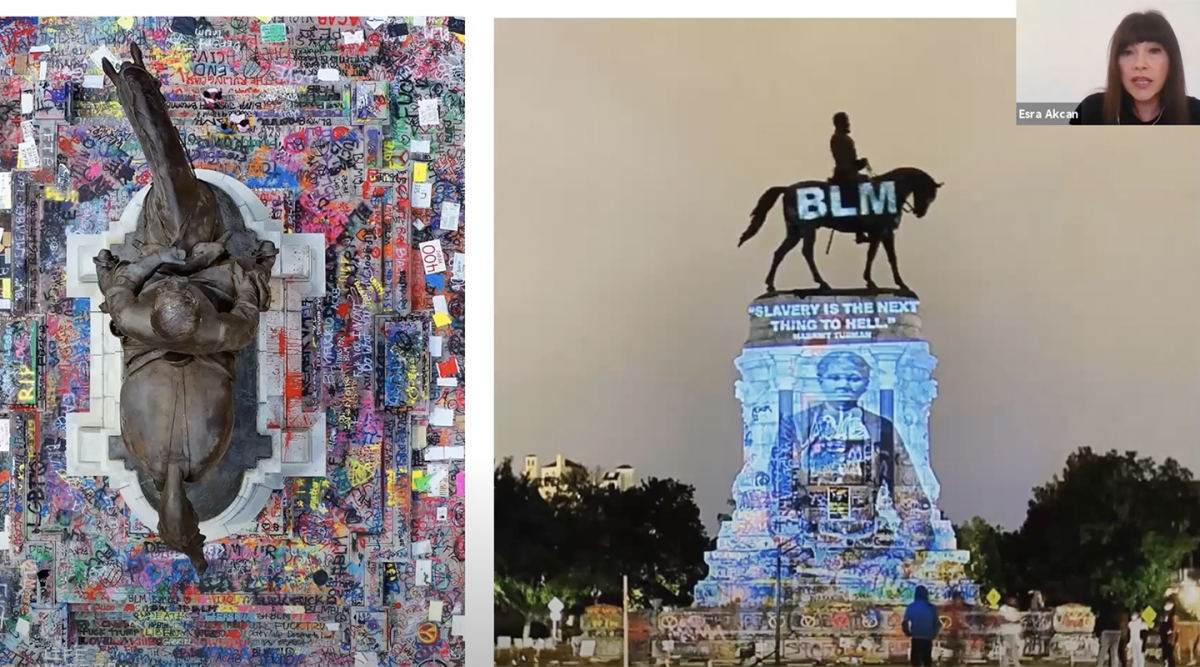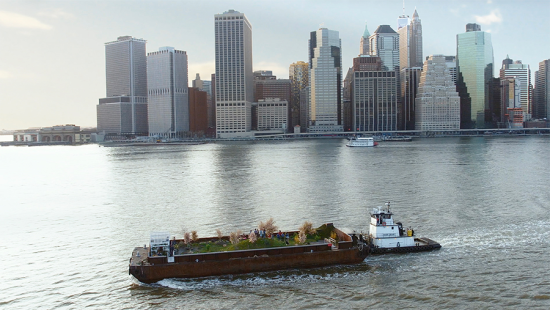COVID-19 and Equity: Rethinking Cities, Pedagogy, and Race
by Patti Witten
AAP faculty and alumni are rethinking key urban design attributes, planning issues, and legacies of colonialism at the heart of inequities based on class and perceptions of race.

Designers, architects, historians, planners, and artists continue to respond to economic disparity, racial bias, and a host of other social issues illuminated by the COVID-19 pandemic and citizen protests condemning violence and injustice in our cities and communities.
From webinars on the future of monuments to research on pandemic resiliency to curricular and co-curricular programming, AAP faculty and alumni are rethinking key urban design attributes, planning issues, and challenging legacies of colonialism at the heart of inequities based on class and perceptions of race both in the U.S. and around the world.
Multi-layered, systemic, and interconnected inequities revealed by the pandemic and public outcry show how public health, social equity, racial justice, climate change, sustainability, resiliency, and access to amenities in our cities are deeply linked. The last nine months have shown that communities need support. Models such as mutual aid invoked by people dedicated to offering what knowledge and resources they have are essential to learning from our concurrent social and public health crises and to working toward lasting structural change in our cities, neighborhoods, and institutions.
Decolonizing Pedagogy, Policy, and Public Spaces
Following the killing of George Floyd and the nationwide calls for racial justice, the college has begun a new conversation on a shared vision for diversity, inclusion, and accountability. In response to Dean Yoon's June 2 message to the community titled The Urgency of Now, students, faculty, staff, the alumni committee on diversity, and another group of alumni that formed to advocate for the reestablishment of what was formerly called the Office of Minority Educational Affairs, have come together to shape a shared vision for an anti-racist AAP.
In addition to the college-wide conversation, the Cornell University chapter of the National Organization of Minority Architecture Students (NOMAS) sent a letter (June 20) to the dean and larger AAP community, expressing a desire to "aid in creating a diverse and inclusive space that supports and gives a voice to members of our community who have felt unheard."
NOMAS's letter detailed a three-part proposal for action to ensure that all Black student needs for support are heard by faculty and staff, and to see that curricula and programming take these needs into account. The letter calls for the recruitment of faculty who are Black or People of Color, transparency in disciplinary action following bias reporting, and, in line with the alumni group's vision, a request that an office or position dedicated to diversity and inclusion be established and supported indefinitely by the college.
To date, the college's Council for Diversity & Inclusion (D&I) has cohered input from individuals and groups to formulate a plan for a review of hiring protocols, programming, anti-bias training, and pedagogy, to reporting on the current state of affairs and progress toward change. Associate Professor Neema Kudva, CRP, and Assistant Professor Samia Henni, History of Architecture and Urban Development (HAUD) co-chair the council that will align college actions with the AAP's statement of inclusion that states, in part, that "We embrace creative and analytic practices that challenge preconceptions and prejudice; encourage critical engagement with the many forms of built culture; and defend the prerogative of our disciplines to ask difficult and provocative questions."
Some of this work is already underway in the disciplines, including the HAUD program which Yoon's June 18 message describes as "lead[ing] scholarship in counternarratives challenging colonialist and design discourse that are influenced by western bias." Henni's recent essay responding to the federal draft executive order, "Making Federal Buildings Beautiful Again," for example, aims to "unpack the violent coloniality that the text of the executive order embodies [as] the conservative demand for adopting a universal architectural language is unsurprisingly rooted in the coloniality of power, and its totalizing claims should be contested and opposed."
With her work that encompasses research, writing, and exhibition, Henni advocates for an approach to historiography that disrupts the colonial, or modern Eurocentric, ramifications of power on education and architectural practice. This fall, she will teach Into the Desert: Coloniality and Toxicity as part of the 2020 Preston H. Thomas Memorial Symposium. The symposium consists of a series of weekly lectures to take place weekly alongside Henni's seminar exploring "the ways in which politicians, scientists, and architects developed, exploited, colonized, transformed, urbanized, militarized, or polluted the underground or overground territories of deserts in the aftermath of WWII."

Professor Esra Akcan, also in the HAUD program, initiated a panel discussion this July intended to reevaluate the purpose and symbolism of public memorials and monuments with a webinar titled "Racism and the Future of Memorials." Akcan, as well as invited panelists Mwanzaa Brown (M.Arch. '18), and Manisha Sinha, Chair in American History at the University of Connecticut shared their thoughts on how architects can take a more proactive role in attempts to come to terms with large-scale past abuses and achieve accountability and reconciliation by engaging in the accountability debate, adopting inclusive practices in the design professions, and advancing transitional justice as a means for peacebuilding. The panel presentations were followed by a Cornell NOMAS-led Q&A led by Farzana Hossain (B.Arch '22), and Chi Yamakawa (B.Arch. '21).
Beyond Cornell, but not without local impact for AAP, alumna and NOMA president Kimberly Dowdell (B.Arch. '06) remains engaged in conversations about race and racism in design practice, city government, and institutions of higher education. Since the start of the pandemic in the U.S., Dowdell has spoken and written frequently on the importance of including architects in discussions, especially following the killing of George Floyd in May and as public protests erupted afterward. As government and healthcare officials look for ways to support and strengthen communities disproportionately affected by the pandemic, she says policy changes must provide greater access to resources, amenities, and healthcare to these communities.
"Somehow within a 90-day period, we've experienced as a nation a recap of the Spanish flu, the Great Depression, and the Civil Rights Movement in a very tiny period of time," Dowdell has said, projecting that "we're going to be in a space with a lot more people, in the same cities, and be far more diverse than even we're seeing now."
Focused directly on confronting racist histories with architectural design, Dowdell says that at the top of her mind is a sort of Hippocratic oath for all licensed architects, requiring them to protect the "health, safety, and welfare" of the public.
"This isn't just a public health problem. It's a design problem," she writes.
Environmental Justice, Resiliency Planning, and Urban Governance
In a July interview for the Slate podcast What Next: TBD, CRP professor Mildred Warner said, "The Government's job is to be countercyclical to the economy, so at a time when you have a recession, that's when you need to have government spending."
Warner is referring to the current state of cities facing the loss of business and property tax revenues from pandemic-related shutdowns and acknowledges the drawbacks of attempts to reopen that have tended to spark new outbreaks rather than restore the economy to working order.
Based on the response to the fiscal challenges of 2008–09, Warner said cities should be spending more, not less when unemployment rises and the residents struggle — and with the support of the federal government.

"In the Great Recession, we spent our money on Wall Street instead of Main Street," Warner says. "Had the federal government chosen to do something more than they did with the American Recovery and Reinvestment Act, done a lot more of that, it would have been the opportunity to have reinvested in, let's say, water infrastructure — employ people, stimulate industry because you're ordering pipes, rebuilding the water infrastructure."
Also in CRP, Assistant Professor Linda Shi's research on fiscal vulnerability and climate change in Boston and Florida demonstrates the significant risks communities face as sea levels rise. According to Shi, small, dense, and rich coastal areas lose tax base to lower property values and historically Black, lower-income, and disadvantaged communities inland become new sites of gentrification and displacement.
Shi's research focus is urban environmental governance and advancing planning policies to manage climate change in ways that improve social equity rather than see disparities continue to grow and disproportionately impact vulnerable populations.
"The COVID-19 financial crisis accelerates these impacts as municipalities lose funding to invest in short-term infrastructure upgrades," Shi said about her research in Florida coastal areas. "Left unattended, these communities face a vicious cycle of declining property values and funding for services, while inland, lower-income, historically black, and disadvantaged communities become new sites of gentrification and displacement. These findings show the need for regional land use, administrative, and tax reforms to enable equitable adaptation to coastal climate change."
Expanding on this idea, Shi said research on existing urban greening projects finds these projects can cause gentrification and displacement. According to Shi, the practice of green infrastructure should "diversify" to include social and government policy, community development, and agroecology, as well as learning from the Global South and those currently positioned as "off the map" of technical expertise. Urban greening projects also point to the need for interdisciplinary research that provides an evidence base for more transformative social, ecological, and governance strategies.
While Shi's essay focuses on the U.S. context, it is relevant to an international audience given that similar challenges confront cities worldwide and highlights how the Global North can learn from the Global South. The pandemic has revealed global interdependencies and shared vulnerabilities that underscore the critical importance of seeing racial justice and equity as a shared responsibility in the U.S. and around the world. Between the U.S. Black Lives Matter movement and European cities that have adopted transitional justice tactics, as well as efforts to address equity and access in the Global South, a discourse has developed that considers how people all over the world may be treated with respect and dignity, have a voice and equal say in leadership, and are provided services and opportunities that have to now been largely been reserved for the privileged.
The global nature of these problems is both daunting and yet promising in terms of the large-scale change that planners and voices calling for change are demanding. At AAP, the student-led webinar Reshaping the Intersection: Living and Learning Difference and Coexistence in the City, hosted by the Department of City and Regional Planning, examined how the intersection of Urban planning and design's various fields have remained complicit in societies built from structural racism, patriarchy, and economic exploitation.
Public Health, Mutual Aid, and Tech
As we entered 2020, many topics of concern for designers and planners were thought to be found at intersections of areas like climate change, resiliency, and technology. But the past nine months have added a critical public health challenge to the mix, and, as Dean Yoon put it in her May 1 OpEd for CityMetric/Blueprint, a 10-year timeline has compressed response times to weeks or days. As shutdowns and hospitalizations swelled in March, Cornell-led Operation PPE demonstrated the capacity of designers to deploy their knowledge and resources. Associate Professor and Associate Dean for Design Initiatives at Cornell AAP Jenny Sabin, Yoon, alumni colleagues, and students worked quickly to respond to the urgent need for equipment for frontline workers in hospitals with on-demand manufacturing and open-source design files.
This semester, Sabin will continue to work with Cornell Tech to critically engage designers, facilitate collaborations with makers, and explore possibilities in a combined architecture option studio and seminar titled Designing and Making Across Disciplines: Architecture in COVID-19. Part of the Matter Design Computation program Sabin directs, the studio asks how have architects, engineers, and scientists responded to the challenges of COVID-19 in the context of the politicization of masks in the U.S., the disproportionate numbers of Black, Latinx, Indigenous, and minority communities affected the pandemic, and gaps in supply chains of PPE.
The COVID-19 crisis "reveals the vulnerability of urbanizing societies where cities are the focal points of the current pandemic," and achieves an understanding of how urban density, housing, demographic and programmatic mix, mobility infrastructure, walkability, and bike-ability of a city relate to the spreading and containment of pathogens."
Environmental Systems Lab, proposal for Rapid Response Fund grant from the Cornell Atkinson Center for Sustainability
This spring, assistant professor of architecture and director of the Cornell Environmental Systems Lab, Timur Dogan convened a team of epidemiologists and urban designers in an application of computational tools that investigate the nexus of urbanism and pandemics. Their proposal, "Urbanism and epidemics: Short- and long-term design strategies to increase urban resilience to fast-spreading diseases," earned a Rapid Response Fund seed funding grant from the Cornell Atkinson Center for Sustainability. The funding came from a collaboration with Cornell's Master of Public Health Program, the Vice Provost of International Affairs, the SARS-CoV-2/COVID-19 Rapid Response Research initiative, and the Cornell Center for the Social Sciences.
Dogan's Cornell team — Assistant Professor of the Practice in Architecture Martin Miller, systems engineering Ph.D. candidate Yang Yang, and urban designer and housing expert Katharina Kral — took a data-driven approach to re-evaluating longstanding planning paradigms that promote urban density. According to the proposal, the COVID-19 crisis "reveals the vulnerability of urbanizing societies where cities are the focal points of the current pandemic," and achieves an understanding of how urban density, housing, demographic and programmatic mix, mobility infrastructure, walkability, and bike-ability of a city relate to the spreading and containment of pathogens."
These key urban design attributes (KUDA) are closely linked to epidemic resilience, say the authors. They used Urbano.io, a free software launched 2019 and developed with Atkinson RRF and Center for Transportation, Environment, and Community Health support, to compute these KUDAs as well as public health indicators and self-reported well-being, with the aim of impacting the ongoing planning efforts of new cities.
Returning to the issues of colonialism and racism in the U.S., Assistant Professor of the Practice in New Media Jaret Vadera says we live in "an unsustainable society infected with rusted old racist and classist systems that need to be radically reimagined with a very different set of priorities and values."
Radical Reenvisioning in the "Long Days Ahead"
During lockdown this spring, Assistant Professor of the Practice in New Media Jaret Vadera, Department of Art, spent time engaged in mutual aid activities in his Brooklyn neighborhood where he had a clear view of the intersection of public health, race, racism, and cultural life at the height of the pandemic. He calls for a "collective value adjustment."
"If we have the courage to take a long look in the mirror," Vadera says, "we will see how the legacies of settler-colonialism, manifest destiny, genocide, residential schools, slavery, slave patrols, eugenics, immigration laws, and redlining have directly supported white supremacy and shaped the ways that inequity has been consciously built into every layer of our cities and our institutions — privileging some groups while controlling, policing, and exploiting others."
"Artists are uniquely positioned to radically reshape our society," he adds. "We are natural creative problem-solvers, critical-thinkers, conduits, social sculptors, and community-builders. All crucial skills needed in the long days ahead."
Vadera echoes and supports the emerging vision for how designers, educators, and artists across disciplines and spaces may use these crucial skills in rethinking how we live, build, and shape livable, equitable cities:
"It is imperative that we first fully understand our history; so that we can better see our present; and then get to work imagining and creating a more just and sustainable future for all."







